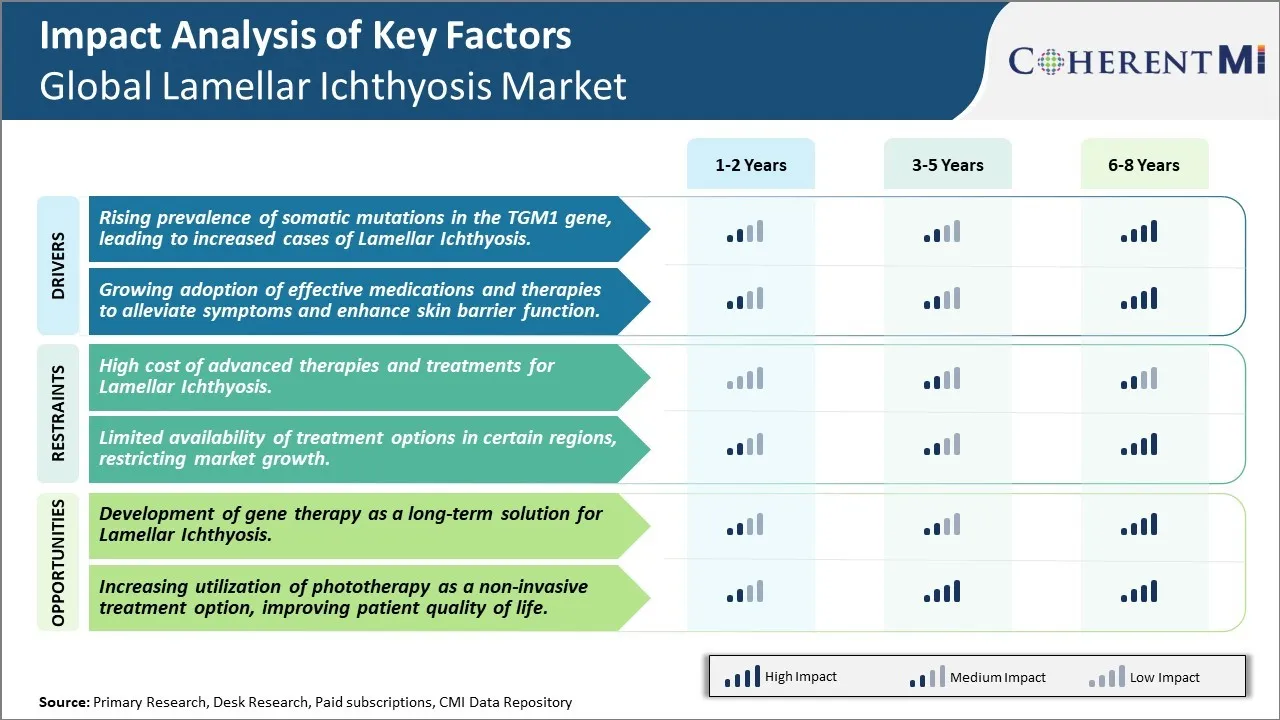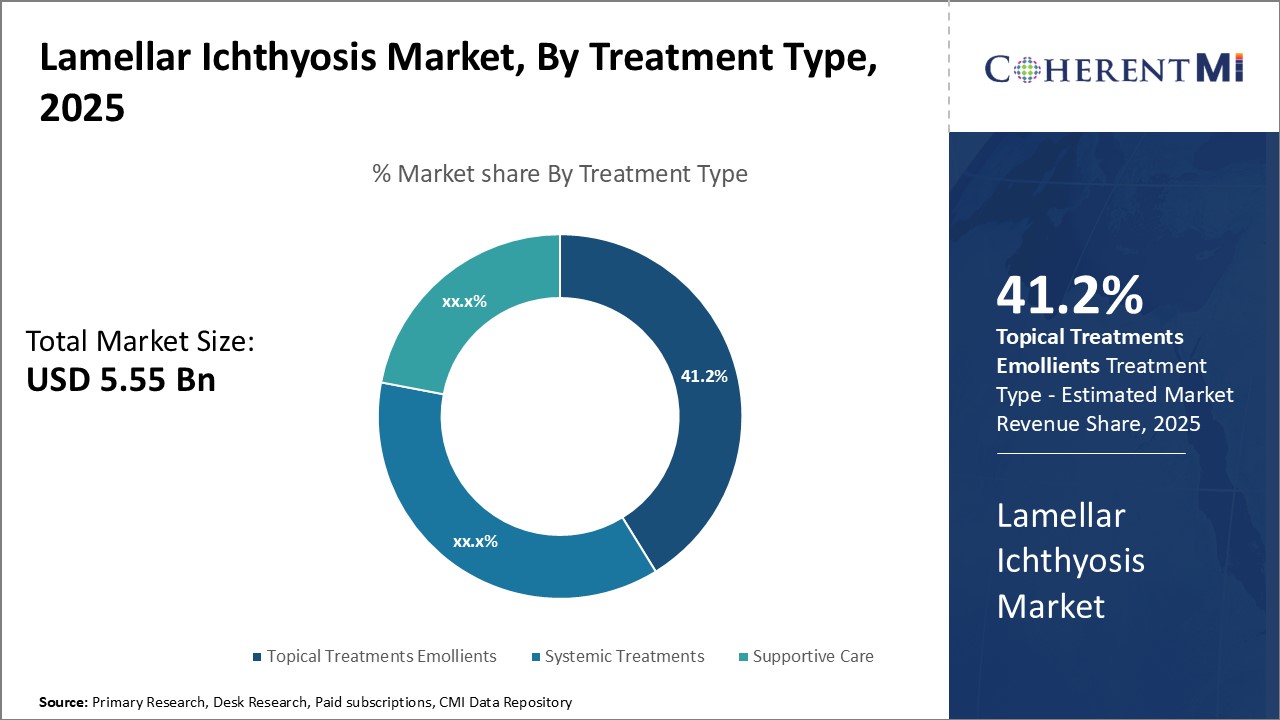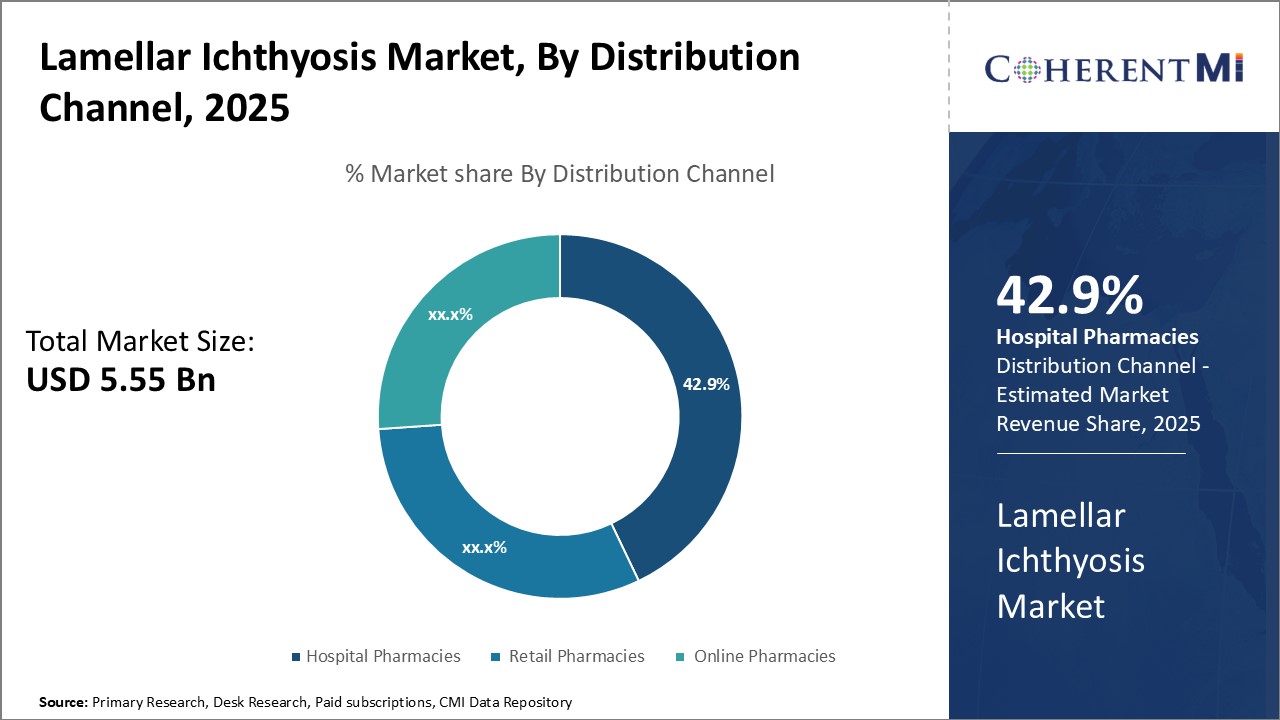Lamellar Ichthyosis Market Size - Analysis
The Global Lamellar Ichthyosis Market is expected to witness steady growth over the forecast period. The development of new combination therapies with improved efficacy and reduced side-effects is creating new opportunities in the market. Moreover, the increasing focus of major pharmaceutical players on rare disease portfolio through mergers, acquisitions and licensing deals will further support market growth in coming years. However, lack of approved treatment options for lamellar ichthyosis and high treatment cost pose challenges to market growth.
Market Size in USD Bn
CAGR4.7%
| Study Period | 2025-2032 |
| Base Year of Estimation | 2024 |
| CAGR | 4.7% |
| Market Concentration | High |
| Major Players | Amgen Inc., Eli Lilly and Company, Pfizer Inc., Novartis AG, AbbVie Inc. and Among Others |
please let us know !
Lamellar Ichthyosis Market Trends
The rising prevalence of somatic mutations in the TGM1 gene is significantly contributing to the increased incidence of Lamellar Ichthyosis cases around the world. Lamellar Ichthyosis is a rare genetic skin disorder characterized by dry, thickened skin with large, dark plates that can resemble scales. It is caused due to mutations in the TGM1 gene which encodes the transglutaminase-1 enzyme involved in formation of the skin barrier.
With advancements in next-generation sequencing technologies and whole exome studies, more asymptomatic individuals are being identified as mosaic for TGM1 mutations with a subpopulation of mutated cells in the skin. It is believed that with widespread application of powerful genomic tools, the identified prevalence of somatic mutations linked to Lamellar Ichthyosis will continue rising going forward. The growing awareness about the association of newly arising somatic mutations with Lamellar Ichthyosis is an important driver as it is helping more atypical cases and asymptomatic individuals get diagnosed that otherwise would have been missed. This factor is directing more patients towards seeking treatment and care, thereby serving to increase the potential market scope over time.
Market Driver- Growing adoption of effective medications and therapies to alleviate symptoms and enhance skin barrier function
Besides, targeted topical therapies like topical retinoids, calcipotriene and sebocyte-maturation modulators are being increasingly preferred for their ability to selectively act on the keratinization process and natural moisturizing factors. Similarly, adjunctive phototherapy with broadband or narrowband UVB is finding wider use owing to its anti-inflammatory effects. Even procedures like laser resurfacing through ablative fractional CO2 laser are revolutionizing management of thickened and scaled plaques. the improved treatment outcomes delivered by these newer medications and technologies will fuel stronger patient and physician confidence over time. Coupled with growing disease awareness, this is helping augment treatment-seeking rate and increase uptake of effective therapies. Cumulatively, these trends are serving to stimulate greater market gains going forward.

The high cost of advanced therapies and treatments available for Lamellar Ichthyosis poses a major challenge for the global Lamellar Ichthyosis market. Developing new generation gene therapies and precision medicines such as exon skipping for treating Lamellar Ichthyosis requires massive investments in R&D by pharmaceutical companies. The costs involved in clinical trials and regulatory approvals further increase the overall price of these new treatment options. For instance, the cost of a single gene therapy treatment for a rare disease can range anywhere between US$500,000 to US$1 million. Additionally, the ongoing treatment costs of Lamellar Ichthyosis which involves lifelong topical moisturizing and specialized medical care are also significant financial burdens for patients and families. The high treatment expenditure discourages patients from regular medical checkups and adherence to prescribed therapies. This poses health risks and negatively impacts the market potential. Widespread adoption of advanced treatments remains a challenge given affordability issues in developing nations with limited healthcare budgets.
The development of safe and effective gene therapies provides a major opportunity for future growth of the global Lamellar Ichthyosis market. Gene therapy involves modification of an individual's genes or insertion of new genes to treat or cure disease. For Lamellar Ichthyosis, gene therapy can potentially provide a long-term cure by rectifying the underlying genetic defects responsible for the condition. Currently, scientific research is ongoing to develop vector systems such as AAV (adeno-associated virus) to deliver corrective genes to skin cells of patients. Several biopharma companies have initiated clinical trials evaluating potential exon skipping gene therapies. If successful, these treatments can revolutionize Lamellar Ichthyosis management by offering significant advantages over existing topical and oral therapies. A one-time curative gene therapy will reduce lifelong healthcare costs and improve patient quality of life. It will increase treatment access and uptake globally. The advent of effective gene therapies can propel stronger market growth in the long run by addressing current challenges and limitations of standard care.
Prescribers preferences of Lamellar Ichthyosis Market
Lamellar Ichthyosis (LI) is a severe inherited skin disorder characterized by dark, thick, scaly skin. Prescribers follow a stepwise treatment approach based on the stage of LI.For mild cases, topical emollients like cetaphil lotion are prescribed to moisturize skin. As LI progresses, topical retinoids become critical. Tazorac cream 0.1%, a second-generation topical retinoid, is often the first line treatment at this stage due to its effectiveness in reducing scaly skin. For moderate-severe LI, topical anthralin or calcipotriene can be addded to the regimen.
Prescribers also consider individual factors like co-morbidities, compliance, skin care routines and response to previous therapies to determine the most suitable treatment plan. Persistent education on proper application of topicals and regular follow-ups are important to achieve optimal management of LI over the long-term.
Treatment Option Analysis of Lamellar Ichthyosis Market
Lamellar Ichthyosis (LI) is a rare genetic skin disorder characterized by thick, dry scaling of the skin. Treatment focuses on managing symptoms which vary depending on the severity and stage of LI. Mild cases are often treated with topical moisturizers and medications.
For patients not responding well to retinoids, second line options include topical calcipotriene (Dovonex) or topical steroids. Calcipotriene works to normalize skin cell maturation and shedding, while steroids reduce scaling and inflammation. Combination therapy with calcipotriene and a low potency steroid provides added benefits over monotherapy.
Key winning strategies adopted by key players of Lamellar Ichthyosis Market
Focus on increasing awareness - Allergan, Avene, and La Roche-Posay have put significant efforts into awareness campaigns about lamellar ichthyosis since 2015. They educate patients and physicians about symptoms and newer treatment options through digital platforms and conferences. This has helped increase diagnosis rates and drive market growth.
Target emerging markets - Between 2013-2018, Galderma expanded into markets like Asia Pacific and Latin America by setting up local manufacturing and lowering prices through subsidies. These strategies helped address nearly 80% of the untreated patient population in these regions. Galderma's revenues from emerging markets grew at a CAGR of 12% during this period.
This demonstrates how increased awareness, product innovation, targeting high growth territories, and strategic M&A have helped global leaders strengthen their positions and capabilities in the lamellar ichthyosis therapeutic area. Data-backed strategic initiatives such as these have been integral to their success.
Segmental Analysis of Lamellar Ichthyosis Market
 Insights, By Treatment Type - Topical treatments lead in managing lamellar ichthyosis due to their effectiveness
Insights, By Treatment Type - Topical treatments lead in managing lamellar ichthyosis due to their effectiveness
Among topical therapies, retinoids have gained popularity due to their unique ability to regulate keratinization. They help normalize epidermal differentiation and desquamation, reducing scaling and thickness of skin. Adapalene and tazarotene are the most widely used topical retinoids. Their localized action minimizes systemic side effects seen with oral retinoids. Convenience of self-administration coupled with direct effect on lesions has made topical treatments the mainstay of management for mild to moderate presentations of lamellar ichthyosis. The broad range of formulations allows customization based on individual disease severity and patient preference. The accessibility through multiple distribution channels also contributes to the large consumer base for topical therapies.

In terms of By Distribution Channel, Hospital Pharmacies contributes the highest share of the market with 42.9% in 2025 due to specialized products, coverage under insurance and expertise in rare conditions. For patients with severe lamellar ichthyosis requiring specialized formulations, phototherapy or strong oral medications, hospital pharmacies play a pivotal role in effective management. These institutions have access to the entire spectrum of treatment options, many of which are unavailable through other channels due to product complexities or insurance coverage constraints.
Additionally, hospitals represent treatment hubs where multidisciplinary teams of specialized dermatologists, geneticists, dieticians and nurses collaboratively manage each case. Reliable access to expert guidance drives continued adherence to therapy through hospital pharmacies. These attributes have established them as the foremost point of care for severe lamellar ichthyosis in most countries.
Additional Insights of Lamellar Ichthyosis Market
The Lamellar Ichthyosis market is expected to grow steadily due to the rising prevalence of the disorder and advancements in treatment options. The market's growth is driven by an increasing understanding of the genetic causes of the disease, leading to the development of targeted therapies such as gene therapy. Phototherapy is also becoming a more popular treatment option, as it offers a non-invasive approach to managing symptoms. The market's future looks promising, with ongoing research and development efforts focused on finding more effective and long-lasting treatments. The geographical segmentation of the market shows that the United States has the largest patient pool, which also translates to the largest market share. This trend is expected to continue as new treatments become available and more patients seek out specialized care for their condition.
Competitive overview of Lamellar Ichthyosis Market
The major players operating in the Global Lamellar Ichthyosis Market include Regeneron Pharmaceuticals, Inc., AstraZeneca PLC, Sanofi S.A., Roche Holding AG, Vertex Pharmaceuticals Incorporated, Dermira, Inc., Galderma S.A., L'Oreal S.A., Johnson & Johnson, Mylan N.V., Haleon plc, Bristol-Myers Squibb Company, Sientra, Inc. and Eucerin (Beiersdorf AG).
Lamellar Ichthyosis Market Leaders
- Amgen Inc.
- Eli Lilly and Company
- Pfizer Inc.
- Novartis AG
- AbbVie Inc.
Lamellar Ichthyosis Market - Competitive Rivalry

Lamellar Ichthyosis Market
(Dominated by major players)
(Highly competitive with lots of players.)
Recent Developments in Lamellar Ichthyosis Market
- In May 2020, Krystal Biotech announced interim results from their Phase 1/2 clinical trial of KB105, a topical gene therapy for treating autosomal recessive congenital ichthyosis (ARCI). The results, presented at the Society for Investigative Dermatology (SID) annual meeting, indicate that KB105 could effectively address the underlying genetic defect in ARCI, a severe skin disease. Based on these positive early results, Krystal plans to include pediatric patients in the next phase of the trial and continue exploring the potential of KB105.
- In May 2022, Timber Pharmaceuticals has received FDA Breakthrough Therapy designation for TMB-001, a topical isotretinoin using the company’s IPEG delivery system, for treating congenital ichthyosis (CI). This designation highlights the potential of TMB-001, following promising results from the Phase 2b program. The company is now preparing to begin dosing in the pivotal Phase 3 ASCEND clinical trial.
Lamellar Ichthyosis Market Segmentation
- By Treatment Type
- Topical Treatments
- Emollients
- Keratolytics
- Systemic Treatments
- Retinoids
- Other oral medications
- Supportive Care
- Moisturizers
- Bathing products
- Topical Treatments
- By Distribution Channel
- Hospital Pharmacies
- Retail Pharmacies
- Online Pharmacies

Would you like to explore the option of buying individual sections of this report?
Vipul Patil is a dynamic management consultant with 6 years of dedicated experience in the pharmaceutical industry. Known for his analytical acumen and strategic insight, Vipul has successfully partnered with pharmaceutical companies to enhance operational efficiency, cross broader expansion, and navigate the complexities of distribution in markets with high revenue potential.
Frequently Asked Questions :
How big is the Lamellar Ichthyosis Market?
The Lamellar Ichthyosis Market is estimated to be valued at USD 5.55 in 2025 and is expected to reach USD 7.65 Billion by 2032.
What are the major factors driving the Global Lamellar Ichthyosis Market growth?
The rising prevalence of somatic mutations in the tgm1 gene, leading to increased cases of lamellar ichthyosis. and growing adoption of effective medications and therapies to alleviate symptoms and enhance skin barrier function. are the major factor driving the Global Lamellar Ichthyosis Market.
Which is the leading Treatment Type in the Global Lamellar Ichthyosis Market?
The leading Treatment Type segment is Topical Treatments.
Which are the major players operating in the Global Lamellar Ichthyosis Market?
Regeneron Pharmaceuticals, Inc., AstraZeneca PLC, Sanofi S.A., Roche Holding AG, Vertex Pharmaceuticals Incorporated, Dermira, Inc., Galderma S.A., L'Oreal S.A., Johnson & Johnson, Mylan N.V., Haleon plc, Bristol-Myers Squibb Company, Sientra, Inc., Eucerin (Beiersdorf AG) are the major players.
What will be the CAGR of the Global Lamellar Ichthyosis Market?
The CAGR of the Global Lamellar Ichthyosis Market is projected to be 4.7% from 2025-2032.